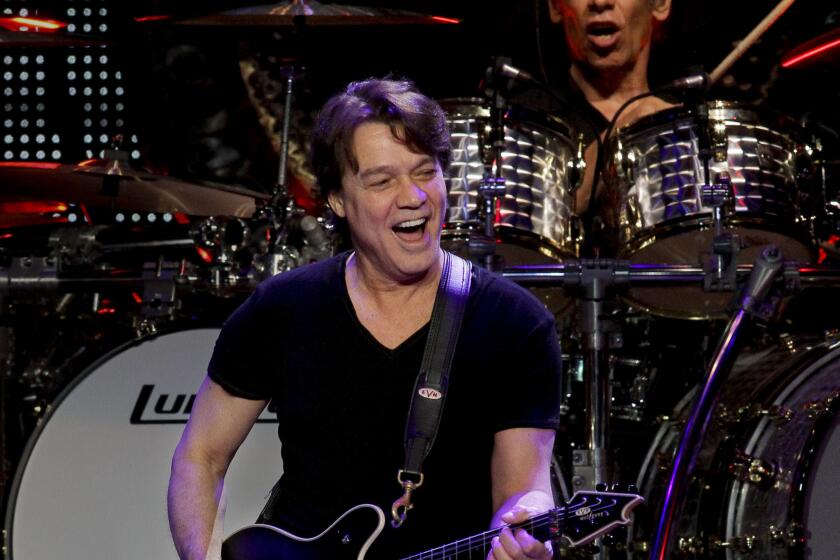The blues return to Oakland’s 7th Street
OAKLAND — Ronnie Stewart bent down along the sidewalk beneath West Oakland’s regional transit station and gingerly slid a prototype plaque into place. After more than two decades of cajoling, his Walk of Fame was finally taking shape.
A trail of granite markers adorned with musical notes and this city’s signature oak tree soon will decorate 7th Street, bearing the names of 84 rhythm-and-blues greats who in the 1940s turned this now mostly barren corridor into a “Harlem of the West.”
“Twenty-one years. That’s a bite out of anyone’s life,” said Stewart, 62, a guitarist who co-founded the Bay Area Blues Society and in 1990 made it his personal mission to connect West Oakland with its largely forgotten musical past.
Sporting a sky-blue blazer and checkered cap during a recent tour of the neighborhood, Stewart related some highlights:
Big Mama Thornton, T-Bone Walker and Aretha Franklin played the bustling clubs after World War II, when soldiers, sailors and railroad sleeping car porters hopped and swayed to the music.
At Bob Geddins’ Big Town recording studio across the street, Rick Darnell and Roy Hawkins teamed in 1951 to write “The Thrill Is Gone,” a song that later propelled B.B. King to superstardom.
“It was a huge blues center,” said Caroline C. Crawford, an affiliate scholar at UC Berkeley’s Bancroft Library who collects oral histories of the era. “It was something like Central Avenue in scope, but it never got recognized ... because the Bay Area is not considered a huge music center like Los Angeles.”
Indeed, on a street now better known for gunfire and drug sales, the sounds of West Coast blues were honed.
“Oakland shared a slow mournful blues sound and a heavy rhythmic dance sound,” said Stewart, breaking into song to illustrate his points. (His current band recently opened for King.)
Jazz greats also came through West Oakland: Billie Holiday performed several times at the strip’s Lincoln Theater, when she had “that mean little dog,” Stewart recalled. And as styles evolved, the boom along 7th Street persisted. Al Green made his first West Coast appearance here in the 1960s.
The dynamic music scene brought a bank, pharmacy and other black-owned businesses to the neighborhood. But then came redevelopment.
Homes were razed and families displaced to make way for a postal distribution center. Freeways that promised connection to San Francisco instead surrounded the neighborhood, in effect isolating it. The depot at the western terminus of the First Transcontinental Railroad, which had brought a steady flow of cash-flush black porters to West Oakland and sent them back to the South with fresh-cut records, was shuttered.
In the late 1960s, construction of the Bay Area Rapid Transit’s above-ground commuter track drove in a final, deafening nail, sending screeching trains along 7th Street from dawn to midnight.
Of the old music clubs, only Esther’s Orbit Room, padlocked and shuttered earlier this year, is visible today.
Paul Grabowicz, who directs a new media program at UC Berkeley, teamed with the architecture school and students a few years ago to create a video game based on 7th Street’s history.
Stewart’s push for a Walk of Fame, Grabowicz said, is important “for civic pride, to know when you walk through the area that something vibrant existed right under your feet.”
But it should also serve as a warning to urban planners, he said, “so we don’t make some of the same mistakes.”
There have been other signs of rebirth in the neighborhood of late: a grocery cooperative now anchors a new block of businesses across from the BART station. And an archway to the neighborhood bears the visages of great African American leaders. Thanks to Stewart, a youthful “Ms. Esther” has a place near President Obama and Martin Luther King Jr.
The owner of Esther’s Orbit Room died in May, at age 90. Stewart had promised her recognition, and he’s a man of his word.
The Walk of Fame, part of the Oakland Community and Economic Development Agency’s beautification effort, is being funded in part by the Metropolitan Transportation Commission.
The first plaques, etched with “Oakland Walk of Fame, The Music They Played on 7th Street,” are expected to be laid down by April and will honor, among others, Geddins and Raincoat Jones, a bootlegger-turned-loan shark who helped finance the music clubs.
On the list of future honorees is singer-songwriter “Terrible Tom” Bowden, 73, who still lives in West Oakland.
Bowden got his start on 7th Street at age 9, performing hambone and shining shoes for 10 cents a customer before climbing on stage himself.
A onetime pugilist, he recalled meeting heavyweight boxing champ Joe Louis at Slim Jenkins’ club.
“He didn’t have hands, he had hooves,” said Bowden, who dropped by the Walk of Fame the other day, a red silk handkerchief poking from his jacket pocket, to take a look at the prototype plaque.
Bowden and Stewart will join other musicians at a concert Wednesday night in Berkeley to honor 7th Street’s past.
Along with the Walk of Fame, it’s an effort to educate West Oakland’s residents -- particularly its youth -- about the area’s rich musical past.
As Stewart and Bowden admired the prototypes, Jonte Gamble crossed the street to see what they were up to.
“You’ve got to know where you come from to know where you’re going,” said the 30-year-old Gamble, his San Francisco 49ers cap tucked under a black hoodie as he stared at the mock-ups.
“To have some history of West Oakland in West Oakland,” he said, “that’s beautiful.”
--
More to Read
The biggest entertainment stories
Get our big stories about Hollywood, film, television, music, arts, culture and more right in your inbox as soon as they publish.
You may occasionally receive promotional content from the Los Angeles Times.










